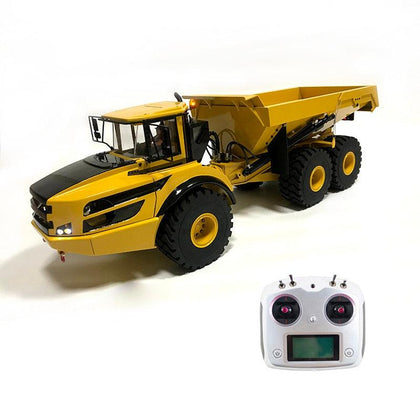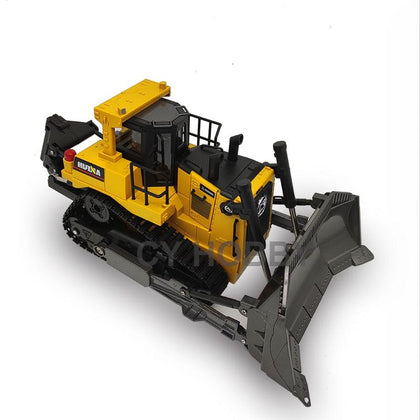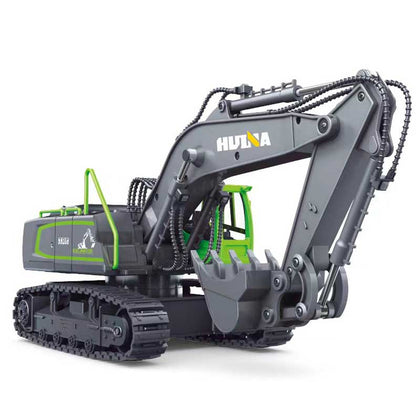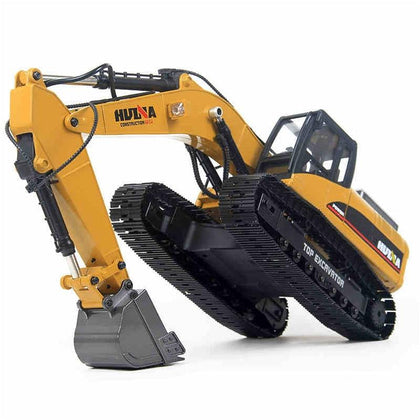Articles
Tonka, Diecast, and Beyond: The Evolution of Construction Toys

Construction toys have always had a certain allure that captivates children and adults. It’s hard to resist the clinking of tiny metal cranes or the vroom of miniature dump trucks as they move through an imaginary construction site.
These toys have a rich history that spans several generations, and as we embark on a nostalgic journey, we’ll dive deeper into the timeline of construction toys. We’ll explore their humble beginnings, from simple wooden blocks to the intricate marvels we see today, including 3D-printed building sets and remote-controlled construction vehicles.
Along the way, we’ll discover the innovations that have made these toys more realistic and engaging, and we’ll appreciate how these playthings have evolved to continue to capture the imagination of children and adults.
A Brief History of Play Construction Equipment Toys
For centuries, construction toys have played a significant role in human history, serving as a source of inspiration and imagination for children across cultures. Imagine the ancient Egyptian kids, fascinated by the magnificence of the pyramids, shaping miniature versions of the exquisite structures from clay, or the young Romans, trying to recreate the marvels of aqueducts they had seen in their playtime. The narrative of construction toys is a vivid tapestry deeply intertwined with our past annals.
Historical records and archaeological findings provide glimpses into the past, revealing that construction play tools have been our companions for millennia. These ancient toys, crafted from materials like clay, wood, or bone, might have been rudimentary, but they were the precursors to the sophisticated playthings we have today. They were the tangible manifestations of human curiosity and the desire to understand and replicate the world around us.

As centuries rolled on, the Renaissance period brought with it a renewed interest in art, science, and innovation. This era of enlightenment is also reflected in the toys of the time. Artisans began producing more detailed and functional toy models, often mirroring the architectural and engineering marvels of the age.
The industrial revolution in the 18th and 19th centuries marked a significant turning point. With advancements in materials and manufacturing techniques, the world of toys transformed. Metals like tin and iron became popular, creating more durable and intricate toy models. During this period, the foundation for modern construction toys was laid.
My Reflections on Vintage Construction Toys
During my trip to London, I enjoyed visiting a charming toy museum with a remarkable collection of vintage construction toys. One toy that caught my eye was a tin crane dating back to the late 1800s, equipped with a winding mechanism. The crane served as a striking testament to the creativity and resourcefulness of our predecessors and the enduring appeal of construction toys. The museum curator also shared fascinating stories about how such toys were often used to teach children about engineering and mechanics, underscoring their educational value.
The history of construction toys reflects our journey as a civilization. From simple clay models in ancient times to the intricate metal toys of the industrial age, they have chronicled our progress, innovations, and aspirations.

The Transition from Simple Wooden Models to Intricate Diecast Replicas
The evolution of construction toys is a fascinating journey, mirroring the broader trajectory of human innovation and craftsmanship. As we moved from the simplicity of agrarian societies to the complexities of industrialized cities, our toys underwent a transformation, both in material and design.
Wood, with its easy availability and malleability, was the primary material for toys for centuries. Children of yore would have played with rudimentary wooden blocks, perhaps carving them into the shapes of their imagination or mimicking the architectural wonders they saw around them. These wooden models, while simple, were the building blocks (pun intended!) of creativity and imagination.
However, as the world industrialized, new materials came into the limelight. The late 19th and early 20th centuries saw the advent of diecasting - a process where molten metal is poured or forced into molds. This technique revolutionized the toy industry. Diecast toys, often made from zinc or lead alloys, were more durable than their wooden counterparts and allowed intricate detailing. The precision that diecasting offered meant that toy models could be accurate replicas of real-world machinery.
Brands like Dinky Toys in the UK pioneered the diecast toy movement in the 1930s, producing detailed miniatures of vehicles, including construction equipment. With their impeccable detailing, these toys became instant hits, not just among children but also among collectors and enthusiasts.
Jake’s Musings Grandfather’s Reflections: The Evolution of ToysI remember my grandfather showing me his prized collection of diecast construction toys. His eyes showed a gleam and spoke about each piece’s craftsmanship and attention to detail. He would often compare them to the wooden toys of his childhood, marveling at the progress and the artistry. For him, these diecast models were not just toys; they were art pieces, each telling a story of an era gone by.
The transition from wooden to diecast toys is emblematic of humanity’s relentless pursuit of perfection. It represents our desire to improve, innovate, and create. While the wooden toys of the past hold a rustic charm, the diecast models of today captivate us with their precision and realism. Together, they tell a tale of progress, passion, and play.
Iconic Brands that Have Shaped the Construction Toy Industry
The construction toy industry has a fascinating and diverse background, spanning a vast expanse of time. Over the years, numerous brands have emerged and impacted the industry, dominating the market and becoming cultural icons in their own right.
These brands have been instrumental in shaping the imagination and creativity of generations, leaving an indelible mark on the hearts and minds of both children and adults alike. From building towering skyscrapers to intricate models of iconic landmarks, the construction toy industry offers endless possibilities for exploration and inspiration.
-
Tonka
No discussion about construction toys would be complete without mentioning Tonka. Founded in 1947, the brand became synonymous with rugged, durable toys, especially their line of trucks. The name “Tonka” itself, derived from the Dakota Sioux word “Tanka” or “Tonka,” which means “great” or “big,” perfectly encapsulates the brand’s ethos. Their toys, often made of pressed steel, were built to last. Many might recall the joy of playing with a Tonka dump truck, feeling its weight and admiring its sturdiness.
-
Matchbox and Hot Wheels
While primarily known for their cars, both Matchbox and Hot Wheels have produced a range of construction vehicles that have been a hit with enthusiasts. With impeccable detailing, their diecast models have often been the first introduction for many to construction equipment toys.

Jake’s Anecdote: My Childhood Menagerie of Construction Toys
Growing up, my room was a treasure trove of construction toys. I had the rugged Tonka trucks, and a smattering of Matchbox vehicles. Each brand brought its unique flavor to its story. I remember spending hours building, creating, and sometimes even destroying, only to start all over again. Those toys were more than just playthings; they were my companions, my tools of imagination.
The legacy of these iconic brands is profound. They have provided countless hours of entertainment and fostered creativity, problem-solving, and a love for building. Their toys have bridged generations, with parents and grandparents sharing their stories, passing them down, and reliving their childhood memories. In the ever-evolving world of toys, these brands stand tall, a testament to their quality, innovation, and the timeless appeal of construction toys.
Frequently Asked Questions
Q: How far back does the history of construction toys go?A: Ah, the history of construction toys is as rich and textured as a well-worn leather armchair! We’re talking ancient civilizations here, folks. Imagine kids in Ancient Egypt playing with miniature pyramids made from clay or Roman youngsters trying to replicate aqueducts. These toys have been our companions for millennia, evolving alongside us as we journeyed through the annals of time.
Q: What was the impact of the Industrial Revolution on construction toys?
A: Ah, the industrial revolution! That was the game-changer, my friends. Before, we had toys made from wood and other natural materials. However, the Industrial Revolution introduced metals like tin and iron. This led to more durable and intricate toys, setting the stage for the modern construction toys we know and love today. It was like going from a black-and-white TV to a 4K Ultra HD screen overnight!
Q: What’s the deal with diecast toys? Why are they so popular?
A: Diecast toys are the rockstars of the toy world! The diecasting process allows for intricate detailing and durability you can’t get with other materials. Brands like Dinky Toys kicked off the diecast movement in the 1930s, and it’s been a hit parade ever since. These toys are so meticulously crafted that they’re not just for kids; collectors and enthusiasts love them, too!
Q: Can you name some iconic brands in the construction toy industry?
A: Oh, where do I start? First off, there’s Tonka, the heavyweight champion of construction toys. These toys are as rugged as possible, often made from pressed steel. And let’s not forget Matchbox and Hot Wheels, known for their diecast cars and range of construction vehicles. Each brand brings its unique flavor, like different instruments in a symphony orchestra.
Q: How have construction toys evolved in terms of educational value?
A: Construction toys have always been more than just playthings; they’re educational tools in disguise! These toys are a treasure trove of learning opportunities, from fostering creativity and problem-solving skills to enhancing fine motor skills and spatial awareness. Brands like LEGO even offer sets that teach kids about mechanics, engineering, and coding. So, the next time you see a kid engrossed in a construction toy, remember they’re not just playing; they’re learning valuable life skills!
Q: What’s the emotional or nostalgic value of construction toys?
A: Ah, the nostalgia! Construction toys are like time machines, transporting us back to our childhoods. They’re not just toys but heirlooms passed down from generation to generation. I remember spending countless hours building and creating with my own set of construction toys, and those memories are as vivid today as they were back then. These toys are the stuff of legends my friends, creating bonds and memories that last a lifetime.
Q: Any final thoughts on the legacy of construction toys?
A: In the grand scheme of things, construction toys are more than just pieces of plastic or metal; they’re the architects of dreams, the builders of imagination. They’ve shaped our childhoods, kindled our passions, and taught us valuable lessons. Their legacy is as enduring as the structures they help us build, standing tall in the annals of toy history. So here’s to construction toys—the unsung heroes that make life much more colorful!

Conclusion
The world of construction toys, with its intricate designs, rich history, and sheer joy it bring, is a testament to the human spirit’s innate desire to create and build. From the rudimentary wooden blocks of yesteryears to the highly detailed diecast models of today, these toys have evolved, mirroring the advancements in technology and design. Yet, their essence remains unchanged – to inspire, educate, and entertain.
Brands like Tonka, Matchbox, and Hot Wheels have not just been manufacturers; they’ve been storytellers, educators, and dream-weavers. They’ve shaped childhoods, kindled passions, and, in many ways, charted the course of the toy industry. Their legacy is evident in the sparkle of a child’s eye as they unbox a new toy, in the nostalgic tales of adults reminiscing about their favorite playthings, and in the collectors’ prized possessions, meticulously cared for over the years.
Jake’s Reflection: As I pen down these thoughts, memories flood back – of rainy afternoons spent building with construction toys, of the sandbox adventures with my trusty Tonka truck, and of the countless races with my diecast construction vehicles. These weren’t just idle pastimes but foundational experiences that shaped my creativity, problem-solving skills, and understanding of the world. In many ways, these toys were my first teachers, introducing me to design, physics, and teamwork concepts.
So, as we stand at the crossroads of the past and the future, let’s take a moment to celebrate these mighty miniatures. They remind us of the simple joys of childhood, the thrill of creation, and the boundless possibilities in a handful of blocks or a toy truck. In the grand tapestry of life, construction toys are not just threads; they are vibrant colors that add depth, texture, and beauty.
References:
- Sutton-Smith, B. (1986). Toys as Culture. New York: Gardner Press.
- Pellegrini, A. D. (2009). The Role of Play in Human Development. Oxford University Press.





